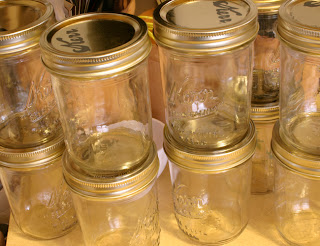I've been trying to cultivate some weeds in the garden this summer, but so far all I've come up with is this nasty tomato infestation:
Well, like they say, when life hands you tomatoes, make tomatoade, right? So I gathered up a number of the more ripe specimens in my garden, 19 to be exact, and set about preserving them. It's really pretty easy. First, grow some tomatoes. Or pick them up at the farmers' market. Or, all else failing, buy them at your local grocery store. Then get yourself some jars:
Now, blanch the tomatoes for one minute in boiling water, then shock them in ice water. This makes the tomatoes much easier to peel. Once you've got them all peeled, pack them into the jars, fill the jars to a half inch from the top with near-boiling water, and add some bottled lemon juice (2 Tbsp per quart, 1 Tbsp per pint; I used pint jars, and added an additional tsp of lemon juice to each jar just to be on the safe side). This is very important, the reason being that ripe tomatoes are not by themselves acidic enough to stave off botulism. And trust me, you don't want to be eating botulistic tomatoes six months from now. Or ever. The added lemon juice will create a sufficiently acidic environment. And yes, you DO need to add acid even if you're using a pressure canner. Just make sure it's not lysergic acid. Save that for your next "lost weekend."
Of course, you'll want to place the lids back on the jars and screw on the rings, but you knew that... Next, place the jars into a bath of boiling water. For pints, boil the jars for at least 40 minutes, for quarts, at least 45 minutes. If you live more than 1,000 feet above sea level, add five minutes. If you live more than 3,000 feet above sea level, add ten minutes. If you live more than 6,000 feet above sea level, invest in an oxygen tank. It should be noted that when you put your jars into the boiling water, the temperature will go down a bit, so start timing once the temperature of the water is back up to 212F, or when the water comes to a rolling boil.
After the speicified amount of time, remove the jars from the water bath. A jar lifter (available at your local hardware store for about $10) will come in very handy here. Let the jars cool, then store them in a cool dry place outside of direct sunlight. What you end up with will look something like this:
Of course, I'm not a food scientist, and you could be forgiven for being skeptical of my instructions. Check out the University of Missouri Ag Extension's guidelines (basically the same ones I used) here for your own peace of mind. Then can yourself some tomatoes!
Friday, August 10, 2007
What the hell do I do with all these tomatoes?
Posted by
Tommy
at
2:47 PM
![]()
Labels: Urban Agriculture
Subscribe to:
Post Comments (Atom)





6 comments:
Funny (but informative) post... that summer bounty! It's either one or the other, famine or overabundance. You've got the right attitude... conserve! I particularly appreciate your link to a reputable (no, no, no comment on your savvy) source for food conservation. Thanks for the info and the nudge to conserve.
Feast or famine indeed, preservation is key... Weird that I'm only now learning this in my 36th year.
Welcome aboard, Gato Azul.
You couldn't have just had a huge salsa fresco party?
I am with trisha on the whole salsa party idea. Yum, yum, yum!
Yeah, well, you're both nuts. Salsa is wack. Everyone knows that. Can those 'maters, CAN 'EM!!!...
Haters can 'maters!
Post a Comment